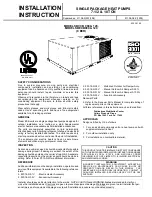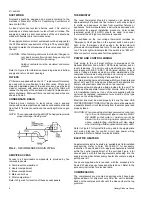
LIMITATIONS
These units must be installed in accordance with the following
national and local safety codes:
1. National Electrical Code ANSI/NFPA No. 70.
2. Local electric utility requirements.
3. Canadian Electrical Code C22.1
4. Canadian Installation Codes CAN1-B149.
Refer to Table 1 for Unit Application Data.
If components are to be added to a unit to meet local codes,
they are to be installed at the dealer’s and/or the customer’s
expense.
Size of unit for proposed installation should be based on heat
loss/heat gain calculation made according to the methods of
Air Conditioning Contractors of America (ACCA).
LOCATION
Use the following guidelines to select a suitable location for
these units.
1. Unit is designed for outdoor installation only.
2. Outdoor coil must have an unlimited supply of air.
3. For ground level installation, use a level concrete slab with
a minimum thickness of 4 inches. The length and width
should be at least 6 inches greater than the unit base rails.
Do not tie slab to the building foundation.
4. Roof structure must be able to support the weight of the unit
and its options and/or accessories. Unit must be installed
on a solid level roof curb or appropriate angle iron frame.
CAUTION:
If a unit is to be installed on a roof curb or
special frame other than a YORK roof curb,
gasketing must be applied to all surfaces that
come in contact with the unit underside.
5. Maintain level tolerance to 1/2" maximum across the entire
length or width of the unit.
OUTDOOR COIL CONDENSATE DRAINAGE
PRECAUTION
Condensate will drain from the outdoor coil during the heating
and defrost cycles. Normally this condensate may be allowed
to drain directly onto the ground/roof. A gravel bed is
recommended to prevent mud splashing.
WARNING: The unit should not be installed in an area where
mud or ice could cause personal injury. Remember
that condensate will drip from the outdoor coil
during heat and defrost cycles and that this con-
densate will freeze when the temperature of the
outdoor air is below 32
°
F.
RIGGING AND HANDLING
Exercise care when moving the unit. Do not remove any
packaging until the unit is near the place of installation. Rig the
unit by attaching chain or cable slings to the lifting holes
provided in the base rails. Spreaders, whose length exceeds
the largest dimension across the unit, MUST be used across
the top of the unit.
BEFORE LIFTING A UNIT, MAKE SURE THAT ITS WEIGHT
IS DISTRIBUTED EQUALLY ON THE CABLES SO THAT IT
WILL LIFT EVENLY.
Units may also be moved or lifted with a forklift. Slotted
openings in the base rails are provided for this purpose.
LENGTH OF FORKS MUST BE A MINIMUM OF 54".
Remove the nesting brackets from the four corners on top of
the unit. All screws that are removed when taking these
brackets off must be replaced on the unit.
Refer to Table 3 for unit weights and to Figure 1 for approximate
center of gravity.
CLEARANCES
All units require certain clearances for proper operation and
service. Refer to Figure 4 for the clearances required for
combustible construction, servicing, and proper unit operation.
WARNING: Do not permit overhanging structures or shrubs to
obstruct outdoor air discharge outlet.
INSTALLATION
Model
BCH090
BCH120
Voltage
Variation
Min. / Max.*
208 / 230V
187 / 253
460V
414 / 506
575V
518 / 630
Wet Bulb Temperature (
°
F)
of Air on Indoor Coil,
Min. / Max.
57 / 72
57 / 72
Dry Bulb Temperature (
°
F)
of Air on Outdoor Coil,
Min. / Max.
45 / 120
45 / 120
*
Utilization range “A” in accordance with ARI Standard 110.
TABLE 1 - UNIT APPLICATION DATA
FIG. 1 - CENTER OF GRAVITY
DIM.
7-1/2 Ton
10 Ton
A
32"
32-1/2"
B
44-3/4"
44"
511.06-N2W
Unitary Products Group
3


































